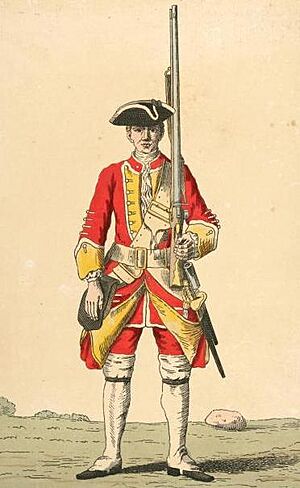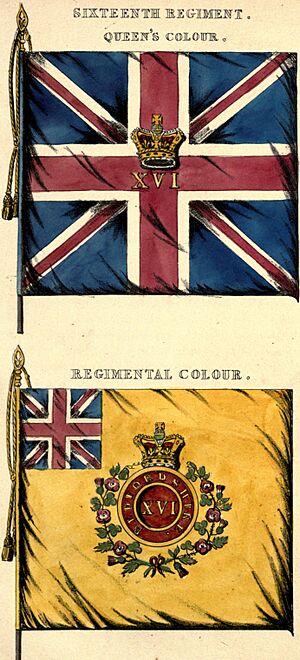Bedfordshire and Hertfordshire Regiment facts for kids
The Bedfordshire and Hertfordshire Regiment was a famous infantry regiment of the British Army. It was first formed way back in 1688! For hundreds of years, this regiment served in many important wars and conflicts, including both the First World War and the Second World War.
In 1958, the regiment joined with the Essex Regiment to become the 3rd East Anglian Regiment (16th/44th Foot). Later, in 1964, it became part of an even bigger group of regiments that formed the Royal Anglian Regiment, which still exists today.
Quick facts for kids 16th (Bedfordshire) Regiment of FootThe Bedfordshire Regiment The Bedfordshire and Hertfordshire Regiment |
|
|---|---|
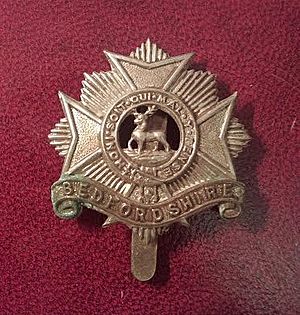
Badge of the Bedfordshire Regiment (around 1914–1918)
|
|
| Active | 1688–1958 |
| Country | |
| Branch | |
| Type | Infantry |
| Role | Line infantry |
| Garrison/HQ | Kempston Barracks, Kempston |
| Nickname(s) | The Old Bucks; The Peacemakers; The Featherbeds; Old Sixteen |
| Colours | Deep yellow facings until 1881, white thereafter |
| March | The Mountain Rose until 1882, La Mandolinata from 1882 |
| Anniversaries | Blenheim Day, August (The Battle of Blenheim, 1704) |
| Engagements | Nine Years War, War of the Spanish Succession, American War of Independence, Second Boer War, Irish War of Independence, First World War, Second World War |
Contents
- History of the Regiment
- Regimental Badges and Uniforms
- Regimental Museum
- Battle Honours
- Regimental Traditions
- Colonels of the Regiment
History of the Regiment
Early Years: 1688 to 1751
The regiment was created on 9 October 1688 in Reading, Berkshire. This happened because people thought William of Orange might invade England. Its first leader was Colonel Archibald Douglas.
The regiment soon went to Flanders (part of modern-day Belgium) to fight in the Nine Years War (1689-1697). They fought in battles like Walcourt, Steenkirk, and Neer Landen. They also helped in the Siege of Namur in 1695.
After this war, the regiment moved to Ireland. When the War of the Spanish Succession started in 1702, they returned to Flanders. They fought in famous battles like Blenheim, Ramillies, Oudenarde, and Malplaquet. These battles were led by the famous Duke of Marlborough.
Later, in 1715, they were in Scotland to help stop the Jacobite Rising of 1715.
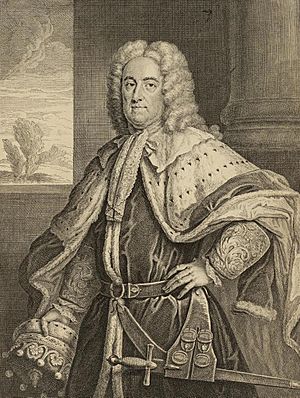
Fighting in the Caribbean
In 1739, the regiment was sent to the West Indies (Caribbean) for the War of Jenkins' Ear. This area was very dangerous because of diseases. Many soldiers got sick with yellow fever and died. Some estimates say 80 to 90% of the troops were lost.
The few who survived returned to England in 1742. The regiment then fought in the War of the Austrian Succession in Flanders. They suffered heavy losses at the Battle of Melle in 1745. After this, they went to Scotland to help with another Jacobite rebellion, but it was already over.
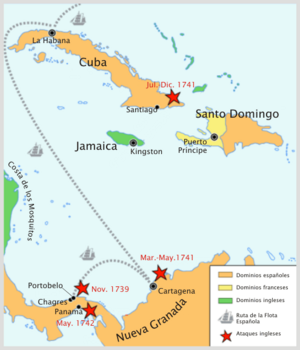
16th Regiment of Foot: 1751 to 1782
In 1751, regiments stopped being named after their colonels. Instead, they were given numbers. So, the regiment became the 16th Regiment of Foot.
American War of Independence
The 16th Foot was in Ireland until 1767. Then, they sailed to Florida in America. When the American War of Independence began in 1776, they were sent to New York.
Later, they returned to garrisons in Florida and Georgia. In 1778, some of the regiment were captured when Baton Rouge fell to Spanish forces. Other parts of the regiment helped defend Savannah and Pensacola. The remaining soldiers returned to England in 1782.
16th (Buckinghamshire) Regiment of Foot: 1782 to 1809
In 1782, county names were added to regiments to help with recruiting. The regiment became the 16th (Buckinghamshire) Regiment of Foot. After the American war, the regiment was made smaller for peacetime. They then served in Ireland.
West Indies Again
In 1790, the 16th Foot sailed to Nova Scotia and then to Jamaica. In 1793, they helped British forces in a local conflict in Saint-Domingue (now Haiti). Sadly, most of the soldiers were wiped out by disease. Only two men from the 16th returned alive to Jamaica in 1794.
The regiment also fought in the Second Maroon War in Jamaica from 1795 to 1796. They returned to England in 1796 and recruited new soldiers.
Capture of Surinam
In 1804, the 16th Foot sailed to Barbados. From there, they joined a force to capture the Dutch colony of Surinam. The Dutch forces surrendered in May. Parts of the regiment stayed in Barbados and Surinam until 1810-1812.
16th (Bedfordshire) Regiment of Foot: 1809 to 1881
In 1809, the regiment changed its name again to the 16th (Bedfordshire) Regiment of Foot. This was because another regiment wanted the Buckinghamshire name.
The regiment did not fight in the Napoleonic Wars in Europe. Instead, they were stationed in England, Scotland, and Ireland. In 1814, they went to Canada. After Napoleon's defeat, they were part of the army occupying France in 1815.
Colonial Service
From 1820, the regiment began a long period of service in different colonies. They were in Ceylon (now Sri Lanka) until 1828. Then they moved to India. They returned to England in 1840-1841.
From 1843, they were in Ireland, then Gibraltar in 1846, and Corfu in 1847. Corfu was a British protectorate at the time. In 1851, they went back to Jamaica, and then to Canada in 1854. They finally returned to the United Kingdom in 1857.
Two Battalions Formed
After the Indian Mutiny in 1857, the British Army needed more soldiers. So, many regiments were allowed to create a second battalion. The 16th Foot formed its second battalion in Ireland in July 1859.
In 1861, both battalions went to Canada. This was to strengthen British forces there because of tensions with the United States during the American Civil War.
The 1st Battalion later moved to Bermuda in 1865, and the 2nd to Barbados in 1866. The 2nd Battalion returned to England in 1869, and the 1st to Ireland in 1870. The 2nd Battalion then moved to Madras in India in 1876.
The regiment was not much changed by the army reforms of the 1870s. They already had two battalions, so they didn't need to merge with another regiment. Their main base became Kempston Barracks near Bedford in 1873.
The Bedfordshire Regiment: 1881 to 1919
New Name and Structure
On 1 July 1881, new army reforms came into effect. Infantry regiments were given names based on areas instead of numbers. So, the 16th Foot became The Bedfordshire Regiment. Its recruiting area included Bedfordshire and Hertfordshire.
The regiment now had two regular battalions, two militia battalions, and three volunteer battalions. The main base was still at Kempston Barracks.
Before the First World War
When it was formed, the 1st Battalion was in Ireland, and the 2nd was in India. The 1st Battalion served in England and Malta before going to India in 1889. In 1895, it helped in the Chitral Expedition. It returned to England in 1908 and was posted to Ireland in 1913.
The 2nd Battalion served in India and Burma until 1891. It then returned to England and later went to South Africa in 1900 to fight in the Second Boer War. After that, it was stationed in England, Gibraltar, Bermuda, and again in South Africa by 1912.
The 4th (Militia) Battalion also sent soldiers to South Africa for the Boer War in 1900.
In 1908, the volunteer and militia forces were reorganised. The regiment now had two reserve battalions and one territorial battalion.
The First World War: 1914 to 1919
The Bedfordshire Regiment grew much larger during the First World War. Its soldiers fought on the Western Front (in France and Belgium) and in the Middle East.
- The 1st Battalion was in Ireland when the war started in August 1914. It fought in many major battles on the Western Front, from the Battle of Mons in 1914 to the Battle of the Sambre in 1918. Private Edward Warner won the highest bravery award, the Victoria Cross, in May 1915.
- The 2nd Battalion was in South Africa when the war began. It arrived in Belgium in October 1914. It fought only on the Western Front, from the First Battle of Ypres in 1914 to the Battle of the Sambre in 1918. Captain Charles Calveley Foss also won the Victoria Cross in March 1915.
- The 3rd (Reserve) Battalion stayed in England, defending the coast around Felixstowe.
- The 4th (Special Reserve) Battalion joined the fighting on the Western Front in July 1916. It fought in battles like the Battle of the Ancre and continued fighting until November 1918. Acting Lieutenant-Colonel John Stanhope Collings-Wells won a Victoria Cross in March 1918.
- The 5th (Territorial) Battalion went to Gallipoli in July 1915. It fought in the Gallipoli Campaign, and later in Egypt and Palestine. Private Samuel Needham won a Victoria Cross in September 1918.
- Many new battalions were formed, called 'Service' battalions (6th, 7th, 8th, 9th, 10th). These were made up of new civilian recruits who joined the army.
* The 6th (Service) Battalion fought on the Western Front from July 1915. * The 7th (Service) Battalion also fought on the Western Front from July 1915. Two soldiers from this battalion, 2nd Lieutenant Tom Edwin Adlam and stretcher bearer Christopher Augustus Cox, won Victoria Crosses. * The 8th (Service) Battalion fought on the Western Front, including the Battle of Loos in 1915.
- Other battalions (like the 9th, 10th, 11th, 12th, 13th) were mainly used for training new soldiers or for home defence in the UK.
- The Hertfordshire Regiment, which was closely linked, also had battalions fighting on the Western Front. Two of their soldiers, Corporal Alfred Alexander Burt and 2nd Lieutenant Frank Edward Young, won Victoria Crosses.
The Bedfordshire and Hertfordshire Regiment: 1919 to 1958
Between the World Wars
In 1919, the regiment was renamed The Bedfordshire and Hertfordshire Regiment. This was to recognise the great service of soldiers from Hertfordshire during the First World War.
After the war, most of the temporary battalions were disbanded. The main battalions were the 1st, 2nd, and 5th (Territorial Army) Battalions.
- The 1st Battalion was in England, then moved to Ireland in 1920. They were involved in some conflicts there before returning to England in 1922. Later, they were stationed in Malta (1925), China (1928), India (1929), and Egypt (1938).
- The 2nd Battalion was in India from 1919 to 1925, and then in Iraq from 1925 to 1926. They returned to England and were sent to help stop the Arab revolt in Palestine in 1936, before returning to England in 1938.
The Second World War: 1939 to 1945
The regiment grew again for the Second World War. New battalions were formed, mainly to train soldiers or for home defence. Only the 1st, 2nd, and 5th Battalions saw active fighting.
- The 1st Battalion was in the Middle East. In 1942, they moved to British India after Japan entered the war. They then served as Chindits in the Burma Campaign of 1944. This was a very tough campaign, and they suffered many casualties, mostly from disease.
- The 2nd Battalion was part of the British Expeditionary Force sent to France in 1939. They were evacuated from Dunkirk in 1940. They spent two years in the UK, preparing for a possible German invasion. Later, they fought in the North African Campaign (1941–42), the Tunisia Campaign (1942–1943), the Italian Campaign (1944), and helped liberate Greece (1944–1945).
- The 5th Battalion was sent to Malaya in early 1942. They surrendered to the Japanese army when Singapore fell. The soldiers spent the rest of the war as prisoners of war (POWs).
At the end of the war in 1945, the 1st Battalion was in British India, and the 2nd was in Greece. The 1st Battalion later moved to Libya and then to Greece, where a civil war had started. The 2nd Battalion moved from Greece to Egypt in 1946 and returned to the UK in 1947.
After the Wars: 1945 to 1958
After the war, the 2nd Battalion was combined with the 1st Battalion in 1948. The 1st Battalion returned to England in 1950. It then moved to Cyprus in 1951, and Egypt in 1952. In 1954, it returned to England for the last time before being posted to Germany in 1956.
Joining Other Regiments
The British Army was made smaller in 1957. So, the 1st Battalions of the Bedfordshire and Hertfordshire Regiment and the Essex Regiment joined together. They formed the 3rd East Anglian Regiment on 2 June 1958. This new regiment then became part of the larger Royal Anglian Regiment in 1964.
The history of the Bedfordshire and Hertfordshire Regiment is now carried on by D Company, 2nd Battalion of The Royal Anglian Regiment.
Territorial Units After Merging
Even though the main battalion merged, the Bedfordshire and Hertfordshire Regiment name continued for the Territorial Army units for another 14 years. In 1961, the 5th Bedfords merged with the 1st Battalion, The Hertfordshire Regiment, to form The Bedfordshire and Hertfordshire Regiment (TA). This unit was disbanded in 1967. Its successor units became part of the Royal Anglian Regiment.
Regimental Badges and Uniforms
When the regiment was formed in 1881, its badges combined symbols from the old 16th Foot and the Hertfordshire Militia. The main badge had a Maltese cross on a star. In the middle was a hart (a male deer) crossing a ford. This design was used for the cap badge, with a circle around it that said the regiment's name.
Early uniforms were red coats with deep yellow parts (called "facings") on the lapels and cuffs. In 1881, when it became The Bedfordshire Regiment, the facings changed to white. Over time, the uniforms changed from red coats to scarlet tunics, and then to khaki for service. Officers had silver decorations on their coats until 1830, then they used gold.
The regiment also wore a black and primrose (pale yellow) lanyard on their uniform blouse. This lanyard is still worn by some territorial units of the Royal Anglian Regiment today.
Regimental Museum
You can learn more about the Bedfordshire and Hertfordshire Regiment at the gallery in Wardown Park Museum in Luton.
Battle Honours
When the regiment was formed in 1881, it didn't have any battle honours listed, even though it had served for almost 200 years! A committee in 1882 fixed this. The Bedfordshire Regiment then received honours for four battles fought under the Duke of Marlborough in the early 1700s. They also received honours for Namur (1695) and Surinam (1804).
Later, they earned honours for fighting in the North West Frontier Province and the Second Boer War. They were awarded over 70 honours for service in the First World War and 18 for the Second World War. Like other regiments, they chose ten honours from each World War to display on their special flags (the Queen's Colour).
Here are some of their selected battle honours:
- Early Wars: Namur 1695, Blenheim, Ramillies, Oudenarde, Malplaquet, Surinam, Chitral, South Africa 1900–02
- First World War: Mons, Marne 1914, Ypres 1914 '15 '17, Loos, Somme 1916 '18, Cambrai 1917 '18, Sambre, France and Flanders 1914–1918, Suvla, Gaza.
- Second World War: Dunkirk 1940, North West Europe 1940, Tobruk Sortie, Belhamed, Tunis, North Africa 1941 '43, Cassino II, Trasimene Line, Italy 1944–45, Chindits 1944.
Regimental Traditions
- The regiment's special march tune is called 'La Mandolinata'. It's a lively song from an Italian opera.
- Every August, the regiment celebrates Blenheim Day. This remembers their ancestors' part in The Battle of Blenheim in 1704.
- From 1938, Queen Elizabeth The Queen Mother was the honorary Colonel in Chief of the Regiment. This special role later passed to the Royal Anglian Regiment.
- Every year, on the first Sunday after Remembrance Sunday, a special service and parade are held at The Keep at Kempston Barracks.
Colonels of the Regiment
The colonels were the leaders of the regiment. Here are some of the important ones:
- 1688–1692: Robert Hodges
- 1692–1705: Honourable James Stanley
- 1730–1763: Roger Handasyd
- 1778–1788: Lt-Gen James Robertson
- 1808–1814: Gen Sir Charles Green, Bt
- 1823–1854: William Beresford, 1st Viscount Beresford
- 1863–1883: Lt-Gen George MacDonald
- 1914–1928: Major-Gen. Thomas David Pilcher
- 1928–1935: F.M. Frederick Rudolph Lambart, 10th Earl of Cavan
- 1948–1958: Lt-Gen Sir Reginald Francis Stewart Denning


